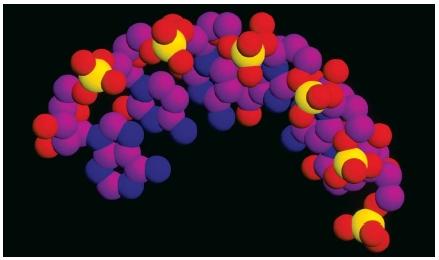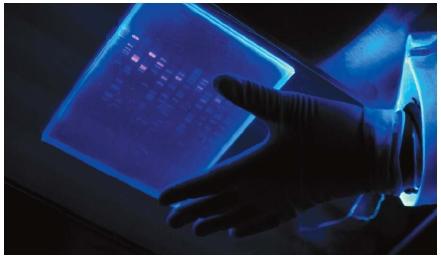Nucleic acid

A nucleic acid is a complex organic compound found in all living organisms. Nucleic acids were discovered in 1869 by the Swiss biochemist Johann Friedrich Miescher (1844–1895). Miescher discovered the presence of an unusual organic compound in the nuclei of cells and gave that compound the name nuclein. The compound was unusual because it contained both nitrogen and phosphorus, in addition to carbon, hydrogen, and oxygen. Nuclein was one of the first organic compounds to have been discovered that contained this combination of elements. Although later research showed that various forms of nuclein occurred in other parts of the cell, the name remained in the modified form by which it is known today: nucleic acid.
Structure of nucleic acids
Nucleic acids are polymers, very large molecules that consist of much smaller units repeated many times over and over again. The small units of which polymers are made are known as monomers. In the case of nucleic acid, the monomers are called nucleotides.
Words to Know
Amino acid: One of about two dozen chemical compounds from which proteins are made.
Cytoplasm: The fluid inside a cell that surrounds the nucleus and other membrane-enclosed compartments.
Double helix: The shape taken by DNA molecules in a nucleus.
Genetic engineering: The manipulation of the genetic content of an organism for the sake of genetic analysis or to produce or improve a product.
Monomer: A small molecule that can be combined with itself many times over to make a large molecule, the polymer.
Nitrogen base: A component of the nucleotides from which nucleic acids are made. It consists of a ring containing carbon, nitrogen, oxygen, and hydrogen.
Nucleotide: The basic unit of a nucleic acid. It consists of a simple sugar, a phosphate group, and a nitrogen-containing base.
Nucleus: A compartment in the cell that is enclosed by a membrane and that contains its genetic information.
Phosphate group: A grouping of one phosphorus atom and four oxygen atoms that occurs in a nucleotide.
Protein: A complex chemical compound that consists of many amino acids attached to each other that are essential to the structure and functioning of all living cells.
Ribosomes: Small structures in cells where proteins are produced.
The exact structures of nucleotides and nucleic acids are extraordinarily complex. All nucleotides consist of three components: a simple sugar, a phosphate group, and a nitrogen base. A simple sugar is an organic molecule containing only carbon, hydrogen, and oxygen. Perhaps the best-known of all simple sugars is glucose, the sugar that occurs in the blood of mammals and that, when digested, provides energy for their movement. A phosphate group is simply a phosphorus atom to which four oxygen atoms are attached. And a nitrogen base is a simple organic compound that contains nitrogen in addition to carbon, oxygen, and hydrogen.
Kinds of nucleic acids
The term nucleic acid refers to a whole class of compounds that includes dozens of different examples. The phosphate (P) group in all nucleic acids is exactly alike. However, two different kinds of sugars are found in nucleic acids. One kind of sugar is called deoxyribose. The other kind is called ribose. The difference between the two compounds is that deoxyribose contains one oxygen less (deoxy means "without oxygen") than does ribose. Nucleic acids that contain the sugar deoxyribose are called deoxyribonucleic acid, or DNA; those that contain ribose are called ribonucleic acid, or RNA.
Nucleic acids also contain five different kinds of nitrogen bases. The names of those bases and the abbreviations used for them are adenine (A), cytosine (C), guanine (G), thymine (T), and uracil (U). Deoxyribonucleic acids all contain the first four of these nitrogen bases: A, C, G, and T. Ribonucleic acids all contain the first three (A, C, G) and uracil, but not thymine.
DNA and RNA molecules differ from each other, therefore, with regard to the sugar they contain and with regard to the nitrogen bases they contain. They differ in two other important ways: their physical structure and the role they play in living organisms.
Deoxyribonucleic acids (DNA). A single molecule of DNA consists of two very long strands of nucleotides, similar to the structure of all nucleic acids. The two strands are lined up so that the nitrogen bases extending from the sugar-phosphate backbone face each other. Finally, the two strands are twisted around each other, like a pair of coiled telephone cords wrapped around each other. The twisted molecule is known as a double helix.
The function of DNA. One of the greatest discoveries of modern biology occurred in 1953 when the American biologist James Watson (1928– ) and the English chemist Francis Crick (1916– ) uncovered the role of DNA in living organisms. DNA, Watson and Crick announced, is the "genetic material," the chemical substance in all living cells that passes on genetic characteristics from one generation to the next. How does DNA perform this function?
When a biologist says that genetic characteristics are passed from one generation to the next, one way to understand that statement is to say that offspring know how to produce the same kinds of chemicals they need in their bodies as do their parents. In particular, they know how to produce the most important of all chemicals in living organisms: proteins. Proteins are essential to the function and structure of all living cells.
Watson and Crick said that the way nitrogen bases are lined up in a DNA molecule constitute a kind of "code." The code is not all that different from codes you may use with your friends: A = 1, B = 2, C = 3, and so on. In DNA, however, it takes three nitrogen bases to form a code. For example, the combination CGA means one thing to a cell, the combination GTC another, the combination CCC a third, and so on.
Each possible combination of three nitrogen bases in a DNA molecule stands for one amino acid. Amino acids are the chemical compounds from which proteins are formed. For example, the protein that tells a body to make blue eyes might consist of a thousand amino acids arranged in the sequence A 15 -A 4 -A 11 -A 8 -A 5 - and so on. What Watson and Crick said was that every different sequence of nitrogen bases in a DNA molecule stands for a specific sequence of amino acid molecules and, thus, for a specific protein. In the example above, the sequence N 4 -N 1 -N 2 -N 3 -N 4 -N 3 -N 3 -N 1 -N 4 might conceivably stand for the amino acid sequence A 15 -A 4 -A 11 -A 8 -A 5 - which, in turn, might stand for the protein for blue eyes.
When any cell sets about the task of making specific chemicals for which it is responsible, then, it "looks" at the DNA molecules in its nucleus. The code contained in those molecules tells the cell which chemicals to make and how to go about making them.
Ribonucleic acid. So what role do ribonucleic acid (RNA) molecules play in cells? Actually that question is a bit complicated because there are at least three important kinds of RNA: messenger RNA (mRNA); transfer RNA (tRNA); and ribosomal RNA (rRNA). In this discussion, we focus on only the first two kinds of RNA: mRNA and tRNA.
DNA is typically found only in the nuclei of cells. But proteins are not made there. They are made outside the cell in small particles called ribosomes. The primary role of mRNA and tRNA is to read the genetic message stored in DNA molecules in the nucleus, carry that message out of the nucleus and to the ribosomes in the cytoplasm of the cell, and then use that message to make proteins.
The first step in the process takes place in the nucleus of a cell. A DNA molecule in the nucleus is used to create a brand new mRNA molecule that looks almost identical to the DNA molecule. The main difference is that the mRNA molecule is a single long strand, like a long piece of spaghetti. The nitrogen bases on this long strand are a mirror image of the nitrogen bases in the DNA. Thus, they carry exactly the same genetic message as that stored in the DNA molecule.
Once formed, the mRNA molecule passes out of the nucleus and into the cytoplasm, where it attaches itself to a ribosome. The mRNA now simply waits for protein production to begin.
In order for that step to take place, amino acid molecules located throughout the cytoplasm have to be "rounded up" and delivered to the ribosome. There they have to be assembled in exactly the correct order, as determined by the genetic message in the mRNA molecule.
The "carriers" for the amino acid molecules are molecules of transfer RNA (tRNA). Each different tRNA molecule has two distinct ends. One end is designed to seek out and attach itself to some specific amino acid. The other end is designed to seek out and attach itself to some specific sequence of nitrogen bases. Thus, each tRNA molecule circulating in the cell finds the specific amino acid for which it is designed. It attaches itself to that molecule and then transfers the molecule to a ribosome. At the ribosome, the opposite end of the tRNA molecule attaches itself to the mRNA molecule in just the right position. This process is repeated over and over again until every position on the mRNA

molecule holds some specific tRNA molecule. When all tRNA molecules are in place, the amino acids positioned next to each other at the opposite ends of the tRNA molecules join with each other, and a new protein is formed.
Applications
Our understanding of the way in which nucleic acids are constructed and they jobs they do in cells has had profound effects. Today, we can describe very accurately the process by which plant and animal cells learn how to make all the compounds they need to survive, grow, and reproduce. Life, whether it be the life of a plant, a lower animal, or a human, can be expressed in very specific chemical terms.
This understanding has also made possible techniques for altering the way genetic traits are passed from one generation to the next. The process known as genetic engineering, for example, involves making conscious changes in the base sequence in a DNA molecule so that a new set of directions is created and, hence, a new variety of chemicals can be produced by cells.
[ See also Chromosome ; Enzyme ; Genetic engineering ; Genetics ; Mutation ]

-----dsthalore
PLESE SEND TO ME THIS INFORMATION QUICKELY.
THANK YOU